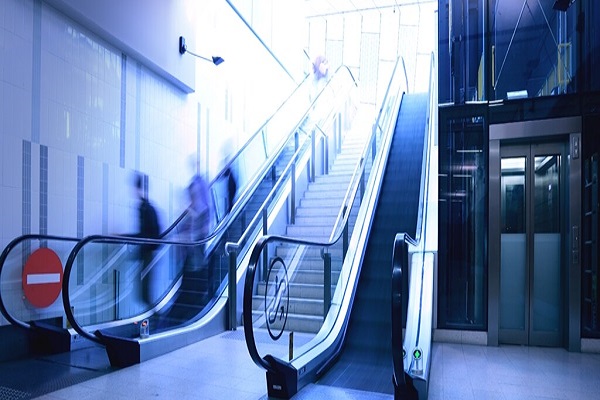China elevator & escalator market was valued is USD 32,602.69 million in 2022 and is expected to rise at 6.78% CAGR during the forecast period. Primary factors accelerating market expansion are rising investments in commercial and residential infrastructure projects in established and developing nations. A machine put in buildings to carry, lift, transport, or move people and commodities from one floor to another is known as a lift. To transport people or things from one level to another, lifts can be utilized in a variety of environments, including residential developments, business buildings, malls, and hospitals. Elevators can also be used in industrial facilities to move supplies, equipment, and finished commodities between floors.
A continuous belt-like arrangement of power-driven moving steps that transports people between floors of a building while continuously climbing or lowering is known as an escalator.
Utilization of UltraRope Technology for High-Rise Buildings
The lift can travel up to a height of around 1,000 meters due to the ultra-lightweight lift lifting technology, known as UltraRope. The demand for UltraRope technology is rising along with the number of high-rise offices and residential structures. For instance, KONE UltraRope from KONE does away with the drawbacks of traditional steel ropes, such as excessive energy consumption, rope stretch, big moving masses, and downtime brought on by building wobble.
Download FREE Sample Report @ https://www.techsciresearch.com/sample-report.aspx?cid=6176
Since it is made of a carbon fiber core and a special high-friction coating, the KONE UltraRope is exceptionally light. This results in an 11 percent reduction in lift energy usage.
Technological Developments by Major Industry Players
Market leaders, such as OTIS, Toshiba, Schindler, and KONE, are investing in IoT and Intelligent Services to track and improve the service of lifts by predicting how frequently the machinery needs to move up or down and the amount of weight that lifts can carry with the destination-based operation. For instance, hospitals and other medical institutions in nations that are particularly affected by Covid-19 were offered digital solution packages based on Thyssenkrupp Elevator’s cloud-driven predictive maintenance platform MAX free of charge. In November 2019, KONE Corporation unveiled the KONE DX Class lifts, a series of digital lifts with built-in connectivity that combines design, technology, new materials, apps, and services.
Increasing Number of Smart Cities
The construction of smart cities includes building information modeling (BIM) and intelligent vertical mobility. Digital technologies are used in smart city solutions to address social, environmental, and economic objectives. Shanghai has underlying factors that allow it to develop into a leading smart city globally. In 2016, the Government of the People’s Republic of China committed to the Smart Cities Plan, which is still going on. Through important domestic programs, including the Smart Cities Plan, City Deals, the Smart Cities and Suburbs Programme, and the National Cities Performance Framework, the government is significantly advancing the development of smart cities.
One of the recent start-ups in China that creates smart city management software and apps is Freedo. A smart city, also known as a digital, intelligent, or wired city, is a metropolitan area where technology and sensors are used to gather data, which is then used in real-time to manage the city’s utilities and resources. For Instance, this is done by enhancing the quality of the city’s infrastructure and services and lowering waste, energy use, and pollution. For machines, cars, systems, and devices to connect with each other, smart cities are built on critical technologies, such as 5G and the IoT. They also rely on an ecosystem of software and data platforms to store and process data in real time. Almost all Chinese provinces and regions have included the idea of smart city development in their development goals for the 14th Five-Year Plan (2021 to 2025). Providing smart governance and services is one of them. More than a billion people utilize China’s national e-government service platform, which offers more than 10,000 standardized services.
Rapid urbanization, economic development, and the uptake of new technologies are predicted to push China cities to install cutting-edge vertical transportation systems, which is anticipated to further boost the country’s escalator and lift the market throughout the forecast period.
Increasing Commercial & Residential Infrastructure
The population of China is expanding quickly (USD 1.4 billion (2021)), which has increased demand for residential and commercial real estate. As a result of the rapid expansion of the building industry in China, escalators and lifts are in great demand in the country.
China has one of the greatest construction industries in the world, and it has grown significantly over the past few decades. Construction activities, including those for homes, businesses, and infrastructure, have increased dramatically in China as a result of the country’s rapid urbanization and industrialization. However, rules intended to deleverage real estate developers have put constant pressure on the building industry in recent years, encouraging more eco-friendly construction activities. The Chinese government has also ordered the construction sector to reorganize its supply chain and operational procedures to cut carbon emissions, implement digital technologies, and enhance the quality and safety of buildings. Notably, the prefabricated building sector must provide approximately 30% of the nation’s output for new development. Another area that the government wants suppliers and contractors to focus on is robotics, notably maintenance companies, and factories that produce building components. Due to the need for construction companies to use newer technology and cut carbon emissions, China expects the market to continue to innovate over the next three to four years.
China spent approximately USD 1 trillion on infrastructure projects in 2022. North China is also emphasizing the development of renewable energy in desert regions. Wind and solar energy projects will start development in 2022 and should be finished by 2030. However, the People’s Republic of China’s Ministry of Commerce reports that, in August 2022, China received close to USD 14.5 billion in monthly FDI inflows. Additionally, FDIs increased by 20% in 2021 compared to the year before, reaching a total of more than USD 170 billion.
Infrastructure development is planned to be vertical to manage the expanding population, with the construction of high-rise structures and skyscrapers, shopping centers, retail stores, and residential flats. Additionally, the need for building renovation is being driven by changes in lifestyle, which is favorably impacting this market. As a result of all these advancements, the China elevator & escalator market is projected to grow during the forecast period.
Market Growth Hindered by High Installation and Maintenance Cost
Since more buildings are being built, the China elevator & escalator market has been expanding quickly. However, escalators and lifts require a significant financial expenditure for installation and upkeep. The complexity of the machinery and the specialized end users have simultaneously raised the price. Additionally, increasing energy usage raises operating costs. Due to the capital-intensive nature of the sector, prospective investors would have to make significant upfront payments for the construction and setup of lifts and escalators. As a result of the demand for these additional technologically sophisticated systems, the cost of installation and maintenance also increases for high-speed escalators’ safety features and associated equipment, control systems, and power efficiency, due to these factors market is likely to be hindered during the forecast period.
Recent Developments
Otis China Upgrades Tianjin Metro with Over 100 Digitally Connected Elevators
- In 2022, more than 120 escalators and Gen3 lifts were supplied by Otis China for the Line 4 northern extension of the Tianjin Metro. The brand-new Gen3 lifts linked to Otis ONE, an IoT-based technology that already provides real-time monitoring and preventive maintenance for Tianjin Metro. The on-site service engineers are supported by the digital ecosystem to offer round-the-clock service to maximize passenger safety and reduce inconvenience. The 22-kilometer Line 4 extension adds 17 stations to the southern segment, which debuted in December 2021 and featured 186 Otis lifts and escalators. The most recent installation brings the total number of Otis units on the growing tube system of the port city to over 1,500.
Market Segmentation
The China elevator & escalator market can be segmented based on type, service, elevator technology, elevator door, end user, and region. Based on type, the market is divided into elevators, escalators, and moving walkways. Based on elevator technology, the market is segmented into traction & machine room-less traction, and hydraulic. Based on elevator door type, the market is divided into automatic and manual. Based on service, the market is divided into modernization, maintenance & repair, and new installation. Based on end user, the market is divided into residential, commercial, institutional, infrastructural, and others. Based on Region, the market is divided into East, North, Northeast, South Central, Southwest, and Northwest.
Market Players
KONE Elevators Co., Ltd., Schindler China Elevator Co. Ltd., Otis Elevator China Co. Ltd., Shanghai Mitsubishi Elevator Co., Ltd, Toshiba Elevator China Co Ltd., Hitachi Elevator (China) Co., Ltd., Disheng Elevator (China) Co., Ltd, Xizi United Holdings Limited, CANNY Elevator Co., Ltd, and General Elevator Co., Ltd. are some of the leading players operating in the China elevator & escalator market.
| Attribute | Details |
| Market Size Value in 2022 | USD 32,602.69 Million |
| Revenue Forecast in 2028 | USD 42,799.96 Million |
| Growth Rate | 6.78% |
| Base Year | 2022 |
| Historic Data | 2018 – 2021 |
| Estimated Year | 2023 |
| Forecast Period | 2024 – 2028 |
| Quantitative Units | Revenue in USD Million and CAGR for 2018-2022 and 2023-2028 |
| Report Coverage | Revenue forecast, company share, competitive landscape, growth factors, and trends |
| Segments Covered | Type
Service End User |
| Regional Scope | East, North, Northeast, South Central, Southwest, Northwest |
| Key Companies Profiled | KONE Elevators Co., Ltd., Schindler China Elevator Co. Ltd., Otis Elevator China Co. Ltd., Shanghai Mitsubishi Elevator Co., Ltd, Toshiba Elevator China Co Ltd., Hitachi Elevator (China) Co., Ltd., Disheng Elevator (China) Co., Ltd, Xizi United Holdings Limited, CANNY Elevator Co., Ltd, and General Elevator Co., Ltd. |
| Customization Scope | 10% free report customization with purchase. Addition or alteration to country, regional & segment scope. |
| Pricing and Purchase Options | Avail customized purchase options to meet your exact research needs. Explore purchase options |
| Delivery Format | PDF and Excel through Email (We can also provide the editable version of the report in PPT/Word format on special request) |
Report Scope:
In this report, the China elevator & escalator market has been segmented into the following categories, in addition to the industry trends which have also been detailed below:
- China Elevator & Escalator Market, By Type:
- Elevator
- Escalator
- Moving Walkways
- China Elevator & Escalator Market, By Elevator Technology:
- Traction
- Machine Room-Less Traction
- Hydraulic
- China Elevator & Escalator Market, By Elevator Door Type:
- Automatic
- Manual
- China Elevator & Escalator Market, By Service:
- Modernization, Maintenance & Repair
- New Installation
- China Elevator & Escalator Market, By End User:
- Residential
- Commercial
- Institutional
- Infrastructural
- Others
- China Elevator & Escalator Market, By Region:
- East
- North
- Northeast
- South Central
- Southwest
- Northwest
Related Reports
Concrete Surface Retarders Market [2028]: Analysis & Forecast
Energy Efficient Glass Market –Overview, Trends [2028], & Analysis
Foam Tape Market [2028]: Trends & Opportunities
Table of Content-China Elevator & Escalator Market
- Product Overview
- Research Methodology
- Executive Summary
- Impact of COVID-19 on China Elevator & Escalator Market
- Voice of Customer
5.1. Factors Influencing Purchase Decision
5.2. Key Challenges Faced
5.3. Key Customer Satisfaction Level
5.4. Annual Maintenance Contract (AMC) Expectation
5.5. Annual Maintenance Contract (AMC) Challenges
- Global Elevator & Escalator Market Overview
- China Elevator & Escalator Market Outlook
7.1. Market Size & Forecast
7.1.1. By Value & Volume
7.2. Market Share & Forecast
7.2.1. By Type (Elevator, Escalator, Moving Walkways)
7.2.1.1. By Elevator Technology (Traction & Machine Room-Less Traction, Hydraulic)
7.2.1.2. By Elevator Door Type (Automatic, Manual)
7.2.2. By Service (New Installation, Maintenance & Repair, Replacement)
7.2.3. By End User (Residential, Commercial, Institutional, Infrastructural, Others)
7.2.4. By Region (East, North-East, South Central, Southwest, North, North-West)
7.3. By Company (2022)
- China Elevator & Escalator New Installation Market Outlook
8.1. Market Size & Forecast
8.1.1. By Value & Volume
8.2. Market Share & Forecast
8.2.1. By Type
8.2.1.1. By Elevator Technology
8.2.1.2. By Elevator Door Type
8.2.2. By End User
8.3. China Elevator & Escalator New Installation Policy
- China Elevator & Escalator Maintenance & Repair Market Outlook
9.1. Market Size & Forecast
9.1.1. By Value & Volume
9.2. Market Share & Forecast
9.2.1. By Type
9.2.1.1. By Elevator Technology
9.2.1.2. By Elevator Door Type
9.2.2. By End User
9.3. China Elevator & Escalator Maintenance & Repair Policy
- China Elevator & Escalator Replacement Market Outlook
10.1. Market Size & Forecast
10.1.1. By Value & Volume
10.2. Market Share & Forecast
10.2.1. By Type
10.2.1.1. By Elevator Technology
10.2.1.2. By Elevator Door Type
10.2.2. By End User
10.3. China Elevator & Escalator Replacement Policy




